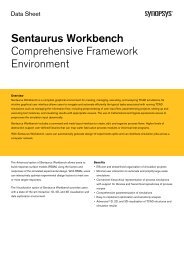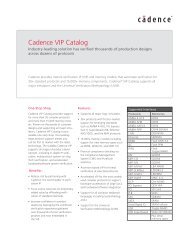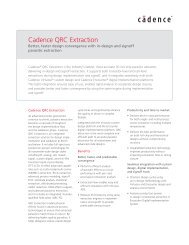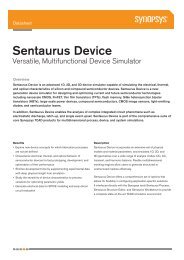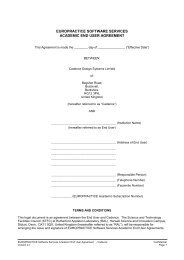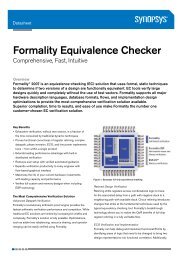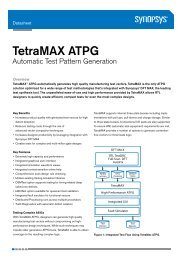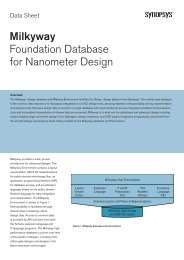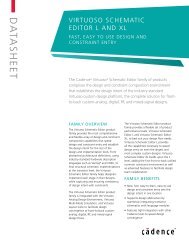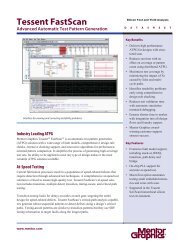Questa ADMS RF - Europractice
Questa ADMS RF - Europractice
Questa ADMS RF - Europractice
- No tags were found...
You also want an ePaper? Increase the reach of your titles
YUMPU automatically turns print PDFs into web optimized ePapers that Google loves.
connections. It is a language-neutral environmentincluding SPICE, VHDL, Verilog as well as standardanalog behavioral languages such as VHDL-AMS and Verilog-A.About Eldo <strong>RF</strong>Eldo <strong>RF</strong> provides the necessary algorithms tohandle <strong>RF</strong> blocks efficiently in typical <strong>RF</strong> transceivers,such as low noise amplifiers, mixers, orvoltage controlled oscillators. It features highperformance<strong>RF</strong>-specific algorithms such as thesteady-state analysis and the modulated steadystateanalysis (MODSST). This provides the necessarysimulation speed-up for these critical blocksoperating at the highest frequencies, typicallyseveral gigaHertz.QUESTA <strong>ADMS</strong> <strong>RF</strong>—HOW DOES IT WORK ?<strong>Questa</strong> <strong>ADMS</strong> <strong>RF</strong> uses the MODSST algorithm ofEldo <strong>RF</strong> in place of the transient algorithm of <strong>Questa</strong><strong>ADMS</strong>. The circuit is described with any mix ofSPICE, Verilog-A, VHDL-AMS, Verilog, and VHDL.The MODSST algorithm is a mixed time-frequencyalgorithm that computes a time-varying spectrum.At discrete time points, the spectrum of the signals iscomputed using the steady-state analysis of Eldo <strong>RF</strong>.The spacing of time points is chosen to follow theslow-varying baseband information, rather than thefast-varying <strong>RF</strong> carriers.This results in huge speed-up ratios over regular transientsimulation. Two or three orders of magnitude areusual with the typical baseband-to-carrier frequencyratios in wireless networks applications.Single Kernel Architecture for <strong>RF</strong>-DSP Simulation<strong>Questa</strong> <strong>ADMS</strong> <strong>RF</strong> is a straightforward extension tothe single-kernel architecture of <strong>Questa</strong> <strong>ADMS</strong> andthus greatly simplifies the usage of its complex underlyingalgorithms.This architecture radically departs from so-calledco-simulation approaches where foreign simulators areglued together, using limited and cumbersome interfaces.It allows you to concentrate on design issues only, notsimulator issues. The usual <strong>Questa</strong> <strong>ADMS</strong> interface isleft unchanged, and the Eldo <strong>RF</strong> MODSST analysis isused in place of the usual transient analysis.Transistor-Level Accuracy<strong>Questa</strong> <strong>ADMS</strong> <strong>RF</strong> differs radically from “systemlevel”approaches, which rely on behavioral modelingbased on proprietary languages or even simple linearizationof the fast-varying <strong>RF</strong> signals. <strong>Questa</strong> <strong>ADMS</strong><strong>RF</strong> retains the full accuracy of circuit-level simulation,where and when you want it to.The critical <strong>RF</strong> blocks can be described in SPICE, sothat all high-order effects are still captured (popularfoundries deliver device model parameters for Eldo,based on the Bsim3, Bsim4, PSP, or HICUM standards).For increased performance, less critical <strong>RF</strong> oranalog blocks can be described in Verilog-A orVHDL-AMS, and all the DSP can be described inVerilog and/or VHDL.www.mentor.com



